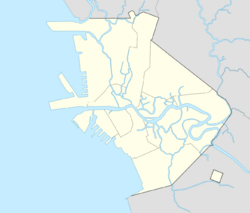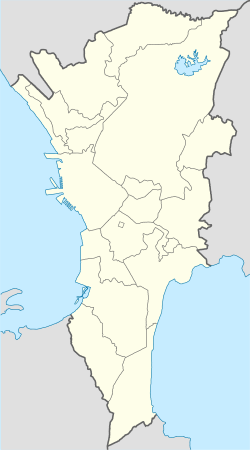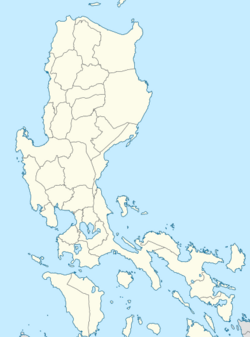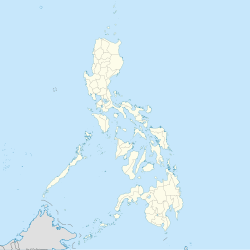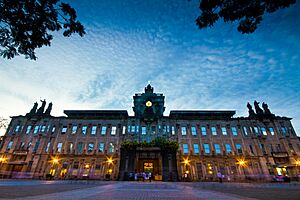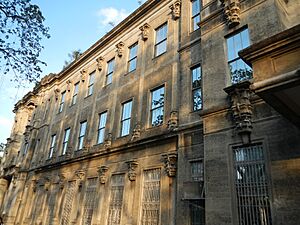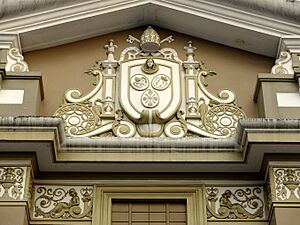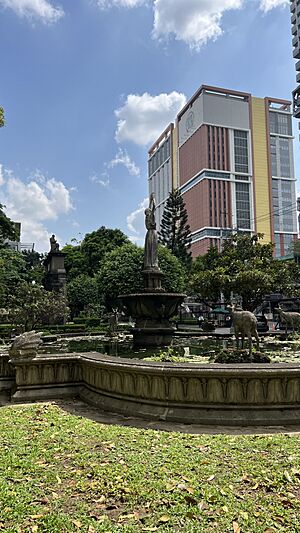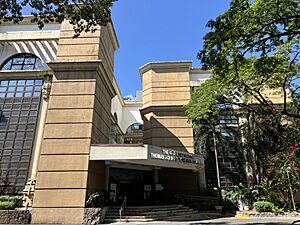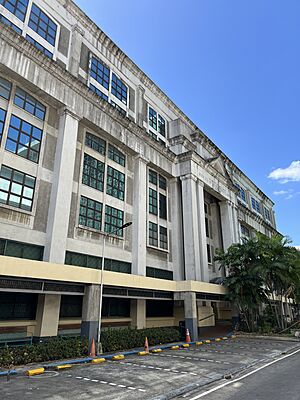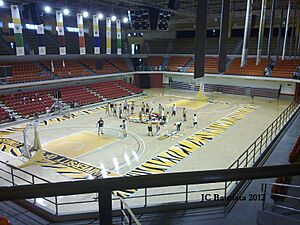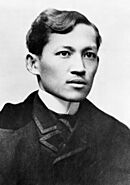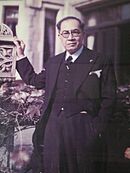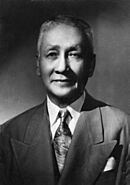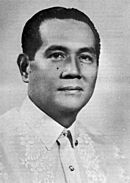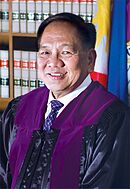University of Santo Tomas facts for kids
|
Pontipikal at Maharlikang Unibersidad ng Santo Tomas, Ang Pamantasang Katoliko ng Pilipinas (Filipino)
|
|
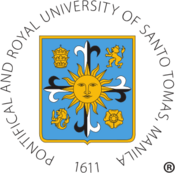
|
|
| Latin: Pontificia et Regalis Sancti Thomæ Aquinatis Universitas Manilana Universitas Catholica Philippinarum | |
|
Former names
|
See list |
|---|---|
| Motto |
Veritas in Caritate
|
|
Motto in English
|
Truth in Charity |
| Type | Private non-profit research university |
| Established | April 28, 1611 |
| Founder | Miguel de Benavides |
|
Religious affiliation
|
Roman Catholic (Dominican) |
|
Academic affiliations
|
|
| Chancellor | Gerard Timoner III |
| Vice-Chancellor | Filemón de la Cruz Jr. |
| Rector | Richard Ang |
| Secretary-General | Louie Coronel |
|
Academic staff
|
2,164 (2019) |
| Students | 35,685 undergraduate and graduate (first term of 2024-2025) |
| Location |
España Boulevard, Sampaloc, Manila
,
Philippines
14°36′35″N 120°59′23″E / 14.60972°N 120.98972°E |
| Campus | Urban 21.5 hectares (215,000 m2) |
| Newspaper | The Varsitarian |
| Patron saints | Thomas Aquinas, Catherine of Alexandria |
| Nickname | Growling Tigers |
|
Sporting affiliations
|
UAAP |
| Mascot | Bengal Tiger |
The University of Santo Tomas (UST) is a private Catholic research university in Manila, Philippines. It was founded on April 28, 1611, by a Spanish friar named Miguel de Benavides. UST has the oldest university charter in Asia. It is also one of the world's largest Catholic universities on a single campus. The university is run by the Dominican Order.
UST received the title Royal from King Charles III of Spain in 1785. In 1902, Pope Leo XIII made UST a pontifical university. Later, in 1947, Pope Pius XII called it The Catholic University of the Philippines. UST has the first and oldest engineering, law, medical, and pharmacy schools in the country. Its main campus is the biggest university campus in Manila. It has 22 colleges, a church, and a teaching hospital. The National Museum of the Philippines has declared four of its buildings and some old documents as National Cultural Treasures.
The university offers many programs, with over 180 choices for undergraduate and graduate studies. Many of its programs are recognized as top-notch by the Commission on Higher Education (CHED). UST also has the most programs accredited by the Philippine Association of Colleges and Universities' Commission on Accreditation (PACUCOA).
Many famous people have studied or taught at UST. These include 30 Catholic saints, four presidents of the Philippines, 17 senators, nine chief justices, and 20 national artists. The university's sports teams are called the Growling Tigers. They have won more overall championships in the University Athletic Association of the Philippines than any other university.
History of UST
The university was started by a Spanish friar, Miguel de Benavides. He came to the Philippines in 1587. He later became the third Archbishop of Manila. When he passed away in 1605, Benavides left his books and money to start a school.
In 1609, permission to open the college was asked from King Philip III of Spain. The university officially opened on April 28, 1611. It was first called the College of Our Lady of the Most Holy Rosary. In 1619, it was renamed Colegio de Santo Tomas to honor St. Thomas Aquinas. In 1645, Pope Innocent X made the college a university under the Pope's authority.
Later, in 1733 and 1734, the Faculty of Canon Law and the Faculty of Civil Law were created. In 1865, Queen Isabella II of Spain gave UST the power to oversee all secondary schools. This meant UST acted like the country's Department of Education.
In 1871, the Faculty of Medicine and Pharmacy was established. José Rizal, a Philippine national hero, studied medicine at UST from 1878 to 1882.
The university moved to its current campus in Sampaloc, Manila in 1927 because the old campus in Intramuros was too small. In 1924, UST started accepting female students.
During World War II, the Japanese forces used UST as a camp for foreign prisoners. The original Intramuros campus was destroyed by fire in 1944. Over 3,700 prisoners were freed in February 1945 by General Douglas MacArthur.
UST was given the title "Royal" by King Charles III of Spain in 1785. This was to thank the university for defending Manila against British troops. In 1974, King Juan Carlos I of Spain visited UST and was given the title Royal Patron.
In 1902, UST was officially declared a pontifical university by Pope Leo XIII. As a pontifical university, it has been visited by popes four times since 1970. These include Pope Paul VI (1970), Pope John Paul II (1981 and 1995), and Pope Francis (2015). In 1947, Pope Pius XII gave it the name The Catholic University of the Philippines.
The first Filipino rector (head) of UST was Leonardo Legaspi, who served from 1971 to 1977. Even during martial law in the Philippines in 1972, the student newspaper The Varsitarian continued to publish.
The university's recognition as the oldest existing university in the Philippines has been discussed. However, the House of Representatives passed a resolution in 2010 confirming UST was "founded on April 28, 1611" and "has the oldest extant university charter in the Philippines and Asia."
In the 2023–2024 school year, over 33,400 students were enrolled in UST's college programs.
University Seal and Colors
The university seal has changed over time. The oldest seal can be seen in an old examination book from the UST Archives.
The seal used from 1868 to 1983 had a shield shape. It featured a globe with a cross and a Dominican dog holding a flaming torch. Below this was the sun of St. Thomas Aquinas. The seal also showed different coats of arms.
- The left side had the Papal insignia, showing the Pope's approval for the college to become a university.
- The right side had the coat of arms of Spain, showing the protection given by Philip IV of Spain.
- The center had the cross of the Dominican order, surrounded by a rosary and the star of Saint Dominic.
The seal also included the university's Latin name and laurel leaves. Over the years, the seal was updated to include the coats of arms of the Commonwealth of the Philippines and later the coat of arms of the Philippines.
In 2011, a new seal was introduced but later changed back due to feedback. The current seal is a modern French shield with the Dominican Cross. It has the full name of UST and its founding year, 1611. The main colors are gold and Marian blue.
The Tongues of Fire is a special logo used for the UST Quadricentennial Celebration (400th anniversary). It shows the outline of the UST Main Building tower and four flames that form the letters UST.
|
||||||||||||||||||||||||||||
Campus Life
The UST main campus is the largest university in Manila. It covers 21.5 hectares in the Sampaloc district. The university moved to this campus in 1927.
The buildings on campus have different architectural styles. This is because they were built at different times. Some early designs were made by university priests and professors. Many new buildings have been added since 2002. Several buildings are named after important Dominican saints.
The center of the campus has famous landmarks. These include the Arch of the Centuries, the Plaza Benavides, and the Main Building. The Arch of the Centuries was once the main entrance to the old campus in Intramuros. It was moved to the current site in 1954. The Main Building was built from 1924 to 1927. It was the first building on the new campus. It houses several colleges and administrative offices.
The campus also has the St. Raymund Penafort Building and health-related buildings. The UST Hospital complex includes several buildings for medical care and training.
Other important areas include the Central Seminary and the Thomas Aquinas Research Complex (TARC). The Botanical Garden, started in 1932, helps students study plants.
The Buenaventura Garcia Paredes, O.P. Building (BGPOP) is also on campus. It is known as the Thomasian Alumni Center. The Quadricentennial Pavilion is a large complex used for sports and events.
The Blessed Pier Giorgio Frassati Building is across from the main campus. It is connected by a bridge. This building houses the Senior High School and other offices. It is the tallest educational building in the Philippines.
A new drainage system was finished in 2021 to help with floods. In 2022, new UST block letters and a Bengal Tiger statue were unveiled.
The campus was declared a National Historical Landmark in 2011. Four of its structures are also National Cultural Treasures.
Satellite Campuses
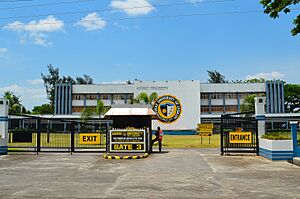
UST in Manila is the main campus of the University of Santo Tomas System. This system includes three other campuses and one new campus being built. UST Angelicum College in Quezon City and University of Santo Tomas–Legazpi in Legazpi, Albay joined the UST System in 2017.
UST Angelicum College offers basic education and college programs. UST-Legazpi is the largest Catholic university in the Bicol Region. It offers courses in law, medicine, engineering, and more.
UST General Santos is a large campus in southern Philippines. It will offer programs in agriculture, business, engineering, and pharmacy. Construction started in 2018, and the campus opened on April 11, 2024.
UST Santa Rosa is a campus in Laguna. It will offer science and engineering programs. Construction for its first building began in December 2020.
University Structure
| College | Year founded |
|
|
|
| Sacred Theology | 1611 |
| Philosophy | 1611 |
| Canon Law | 1733 |
| Civil Law | 1734 |
| Medicine & Surgery | 1871 |
| Pharmacy | 1871 |
| Arts & Letters | 1896 |
| Engineering | 1907 |
| Education | 1926 |
| Science | 1926 |
| Architecture | 1930 |
| Commerce & Business Administration | 1934 |
| Graduate School | 1938 |
| Music | 1945 |
| Nursing | 1946 |
| Rehabilitation Sciences | 1974 |
| Fine Arts & Design | 2000 |
| Physical Education & Athletics | 2000 |
| Accountancy | 2005 |
| Tourism & Hospitality Management | 2009 |
| Information & Computing Sciences | 2014 |
| Graduate School of Law | 2017 |
UST follows the rules of the Roman Catholic Church and the laws of the Philippine government.
The main leaders of the university are the chancellor, vice-chancellor, and rector. The chancellor is the head of the Dominican Order. The rector is the chief executive officer of the university. He is helped by a council and other groups. Each academic department is led by a dean.
UST Manila has 19 regular colleges, three religious colleges, and three basic education schools. These schools work together. Some departments are called "faculties" (like Civil Law) from the Spanish colonial period. Others are called "colleges" or "schools" (like Education) from the American period.
The UST Central Seminary and UST Hospital have their own rules but are still part of the university. The religious colleges (Sacred Theology, Philosophy, and Canon Law) follow special rules from the Pope.
UST has three basic education schools: the Junior High School, Education High School, and Senior High School.
Academic Programs
| Academic year | Total enrollment |
|---|---|
| 2018–2019 | 41,385 |
| 2019–2020 | 40,375 |
| 2022–2023 | 43,631 |
| 2023–2024 | 41,554 |
| 2024–2025 | 42,941 |
UST offers over 63 undergraduate programs and many graduate programs. In the first term of the 2024–2025 school year, 42,941 students were enrolled. The Faculty of Engineering had the most new students. UST also has many foreign students, mostly from Asian countries. The UST Hospital trains medical students.
Admissions Process
To get into UST, students usually take the University of Santo Tomas Entrance Test (USTET). The results are released on January 28, the feast day of St. Thomas Aquinas. In 2020 and 2021, due to the COVID-19 pandemic, UST used the UST Admission Rating (USTAR) instead of a test. This rating looked at students' academic records. The USTET resumed in 2022.
The USTET is given in many places, including 35 centers in the Philippines and 8 international locations.
The Faculty of Medicine and Surgery has its own admission process. It includes a psychological exam. Students need good grades and a high score on the National Medical Admission Test (NMAT). About 480 students are accepted each year.
Faculty and Learning
As of 2019, UST has 2,164 teachers. Many of them have master's or doctoral degrees.
The school year has two terms. Grades are given on a 5-point scale, where 1.00 is excellent and 5.00 is failed. All bachelor's degrees at UST include theology courses.
During the COVID-19 pandemic, classes were held online using an "enhanced virtual mode." In 2023, the UST System started using Canvas as its online learning system.
The Doctor of Medicine program is a four-year course. It includes three years of classroom learning and one year of training at the UST Hospital.
The Faculty of Civil Law offers a four-year Juris Doctor (J.D.) degree. They also have master's and doctorate degrees in law.
Research at UST
UST is a university that focuses a lot on research. It spends millions of pesos on research each year.
The university has several research centers. These include centers for natural sciences, culture, arts, humanities, social sciences, education, and health sciences. The main place for research on the Manila campus is the Thomas Aquinas Research Complex.
UST researchers have discovered new plant species, like Vanda ustii. The UST Herbarium, started in the 1870s, has over 11,000 plant specimens. It helps identify and preserve plants.
The UST Zooplankton Ecology, Systematics, and Limnology Laboratory has the only organized collection of zooplankton samples in the Philippines. The UST Collection of Microbial Strains has many types of microbes.
A team of engineering students and faculty, UST Eco Tigers I, won first place in a diesel category at the Shell Eco-Marathon Asia in 2019.
Some UST professors were part of the OCTA Research team. This team helped forecast and analyze the COVID-19 situation in the Philippines. They also developed a model to predict cases and deaths. UST is also setting up a facility called UST VaxLab to develop vaccines.
The university and the Department of Science and Technology (DOST) launched the DOST–TOMASInno Center in 2019. This center helps new technology businesses grow.
The Center for Conservation of Cultural Property and Environment in the Tropics (CCCPET) helps protect cultural heritage. It has worked on preserving churches and mapping cultural sites.
UST publishes several academic journals, like Acta Manilana and Unitas. Unitas, started in 1922, is the oldest university-based academic journal in the country.
UST is ranked sixth in the Philippines in the 2024 Alper-Doger Scientific Index. This ranking looks at the performance of scientists.
Sustainability Efforts
UST is consistently ranked in the Times Higher Education's Impact Rankings. These rankings measure how universities contribute to the United Nations' Sustainable Development Goals (SDGs). UST was ranked first among Philippine universities in 2020 for its impact.
The UST Simbahayan Community Development Office helps local communities. It works with students, alumni, and staff to improve society. In 2018, UST partnered with a Lumad school to help indigenous people get an education.
In 2021, a new center was created to research materials for clean energy. In 2023, UST partnered with the government's Climate Change Commission to work on climate change and sustainability.
UST is also installing solar panels on its buildings to use renewable energy.
Libraries and Archives
The Miguel de Benavides Library has over 360,000 books and many electronic resources. It is located in a six-story building. It has several sections and branch libraries.
The Antonio Vivencio del Rosario UST Heritage Library has 30,000 old books published between 1492 and 1900. This collection includes La Guerra Judaica (1492) and the first book printed in the Philippines, Doctrina Christiana (1593).
In 2011, the library started the Lumina Pandit project to preserve and digitize its rare books. This project has scanned millions of pages, including the first edition of José Rizal's Noli Me Tángere.
The Archivo de la Universidad de Santo Tomas (AUST) holds old books, papal documents, and university records. It has the largest collection of old baybayin scripts in the world. Some 17th-century baybayin documents were declared National Cultural Treasures.
The archives also keep the school records of José Rizal. Old Spanish-Hokkien dictionaries from the 17th century were also found here.
Museums and Collections
The UST Museum of Arts and Sciences, founded in 1871, is the oldest museum in the Philippines. It has the country's oldest zoological collection, with over 100,000 animal specimens. It also has a large collection of Philippine mollusks. The museum displays chairs used by popes who visited the university.
The UST Hall of Visual Arts shows restored paintings by famous artists, including José Rizal and Fernando Amorsolo. The Hall of Philippine Religious Images has many religious statues. It includes the largest ivory crucifix made in the Philippines.
Other museums include the UST Medicine Museum and the UST Anatomy Gallery.
Publishing at UST
The UST Publishing House (USTPH) was created in 1996. It combines the Santo Tomas University Press (STUP) and the UST Printing Office. STUP was founded in 1593, making it one of the oldest printing presses in the world.
The publishing house has a bookstore in the UST Main Building. It publishes The Academia, the university's international bulletin, and The Varsitarian, the student newspaper.
Recognition and Rankings
| Centers of Development | Centers of Excellence |
|---|---|
|
|
UST is one of only three private universities given a five-year "autonomous status" by the CHED. This is the highest recognition from CHED.
Twenty-six programs at UST are recognized as Centers of Excellence (COE) or Centers of Development (COD) by CHED. This is the most among private schools. UST is also one of only three Philippine universities recognized as a Center of Excellence for its Doctor of Medicine program.
UST has the most accredited programs in the country by PACUCOA since 2011. As of July 2024, 59 of its programs are accredited.
UST became a member of the ASEAN University Network-Quality Assurance (AUN-QA) group in 2016. In 2020, it was the first associate member to get an institutional certification.
All six engineering programs at UST are accredited by the Accreditation Board for Engineering and Technology (ABET).
| Ranking | Year | Rank |
|---|---|---|
| QS World University Rankings | 2025 | 851–900 |
| Times Higher Education World University Rankings | 2025 | 1501+ |
| QS Graduate Employability Rankings | 2023 | 251–300 |
| QS Asia University Rankings | 2025 | 181 |
| Times Higher Education Asia University Rankings | 2024 | 601+ |
| QS National Ranking | 2024 | 4 |
| Times Higher Education National Ranking | 2025 | 3 |
UST was the first Philippine university to receive four stars and then five stars from Quacquarelli Symonds (QS) Stars. It earned five stars for teaching, employability, internationalization, and facilities. QS also gave a five-star rating to its Doctor of Medicine program.
The UST Graduate School has seven programs in the Eduniversal 2023 Business Schools Ranking. This is the most among Philippine institutions.
International Connections
UST has partnerships with 171 universities in 32 countries. It offers dual-degree programs and special programs with universities like the University of Reading and the University of Leeds. Nursing students can also participate in global health courses with Duke University. Medical Technology students can do internships in Thailand.
Student Life and Traditions
UST has many traditions influenced by its Catholic and Filipino culture. These include:
- Misa de Apertura and Discurso de Apertura: A Mass and lecture that open the academic year.
- Thomasian Welcome Walk: New students walk under the Arch of the Centuries.
- Roarientation and Alab: Orientation events for new college and basic education students.
- UST Paskuhan: Month-long Christmas celebrations with concerts and light shows.
At the end of the school year, there is a Baccalaureate Mass and the Ceremony of the Light for graduating students. Students also parade through the Arch of the Centuries, marking the end of their time at UST.
Even during the COVID-19 pandemic, many traditions continued online. In 2022, these events returned to being held in person.
Every day, activities on campus stop at 12:00 PM and 6:00 PM for the Angelus prayer, and at 3:00 PM for the 3 o'clock Prayer.
The tiger statue in Plaza Mayor, installed in 2022, became popular when students started putting coins in its mouth for good luck.
The annual Thomasian Goodwill Games is a sports competition among the university colleges.
Student Organizations
UST has hundreds of student organizations. These groups cover many interests, like religious activities, cultural performances, media, and community service. The Central Student Council is the main student government.
The UST Singers is a famous choir that has won international awards. The UST Symphony Orchestra performs regularly. The UST Salinggawi Dance Troupe has won many cheer and dance competitions.
Student organizations at UST have supported important causes, like equality for all students.
Literature and Media
The Varsitarian is the university's student newspaper. Started in 1928, it is the oldest Catholic newspaper in the Philippines. It publishes every two weeks. The publication also hosts Inkblots, a journalism fellowship.
The Tiger Media Network is the university's broadcasting group. It produces content for Tiger TV and Tiger Radio online. UST used to have its own AM radio station, DZST, from 1950 to 1963.
Athletics and Sports
In 1920, UST and other Catholic colleges formed a sports league called Liga Catolica. Later, in 1924, they helped create the NCAA. UST won its only NCAA basketball championship in 1930.
In 1932, UST left the NCAA and formed the Big 3 League. This league, along with Far Eastern University, later formed the University Athletic Association of the Philippines (UAAP) in 1938.
The university's sports teams were first called the Glowing Goldies. They were renamed the Growling Tigers in 1992. The women's teams are the Tigresses, and the high school teams are the Tiger Cubs.
UST has won the most overall championship titles among the eight UAAP schools. As of 2024, UST has won the seniors' division 47 times. The university participates in all UAAP events. UST has the most championships in baseball, beach volleyball, judo, swimming, taekwondo, tennis, and table tennis.
The UST men's basketball team has won 18 UAAP titles. In 2006, the Tigers won the championship against the Ateneo Blue Eagles. They also reached the finals in 2012, 2013, 2015, and 2019.
The Golden Tigresses, the women's volleyball team, have won 16 UAAP championships. The men's and women's beach volleyball teams also have the most titles in their league.
The Tiger Jins (taekwondo team) have won the most championships in all divisions in the UAAP.
The Salinggawi Dance Troupe and the UST Yellow Jackets have won eight UAAP Cheerdance Competition titles.
Thomasians cheer "Go USTè!" to support their athletes. This famous chant was created in 1990.
The university has many sports facilities. These include a football field, swimming pool, tennis court, and basketball courts. The Quadricentennial Pavilion has a large arena and training halls for various sports.
Notable People
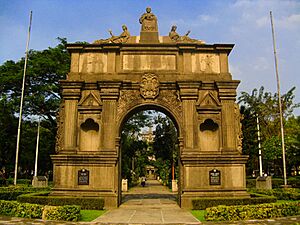
People connected to UST, whether as students, teachers, or leaders, are called "Thomasians." Many famous Thomasians include:
- 30 Catholic saints
- Four presidents of the Philippines: Manuel L. Quezon, José P. Laurel, Sergio Osmeña, and Diosdado Macapagal
- 17 senators
- Nine chief justices
- 20 national artists
- A national scientist
- Five billionaires
In medicine, Thomasians include many former secretaries of health and founders of major hospitals. May Parsons, a UST Nursing alumna, gave the world's first COVID-19 vaccine in the United Kingdom.
Famous Thomasian writers and historians include Nick Joaquin, F. Sionil José, and Gregorio F. Zaide.
In sports, Thomasians include Olympians like Ernest John Obiena (pole vault) and PBA basketball legends Bogs Adornado and Danny Florencio. Rubilen Amit is a world pool champion.
Important people who received honorary degrees from UST include Douglas MacArthur and Corazon Aquino.
Several highways in Metro Manila are named after Thomasians.
-
2nd President of the Philippines
Manuel L. Quezon -
3rd President of the Philippines
José P. Laurel -
4th President of the Philippines
Sergio Osmena -
9th President of the Philippines
Diosdado Macapagal -
26th Chief Justice of the Supreme Court of the Philippines
Diosdado Peralta
See also
 In Spanish: Universidad de Santo Tomás (Filipinas) para niños
In Spanish: Universidad de Santo Tomás (Filipinas) para niños


